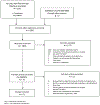Interventions to Improve Patient Comprehension in Informed Consent for Medical and Surgical Procedures: An Updated Systematic Review
- PMID: 31948345
- PMCID: PMC7079202
- DOI: 10.1177/0272989X19896348
Interventions to Improve Patient Comprehension in Informed Consent for Medical and Surgical Procedures: An Updated Systematic Review
Abstract
Background. Patient comprehension is fundamental to valid informed consent. Current practices often result in inadequate patient comprehension. Purpose. An updated review to evaluate the characteristics and outcomes of interventions to improve patient comprehension in clinical informed consent. Data Sources. Systematic searches of MEDLINE and EMBASE (2008-2018). Study Selection. We included randomized and nonrandomized controlled trials evaluating interventions to improve patient comprehension in clinical informed consent. Data Extraction. Reviewers independently abstracted data using a standardized form, comparing all results and resolving disagreements by consensus. Data Synthesis. Fifty-two studies of 60 interventions met inclusion criteria. Compared with standard informed consent, a statistically significant improvement in patient comprehension was seen with 43% (6/14) of written interventions, 56% (15/27) of audiovisual interventions, 67% (2/3) of multicomponent interventions, 85% (11/13) of interactive digital interventions, and 100% (3/3) of verbal discussion with test/feedback or teach-back interventions. Eighty-five percent of studies (44/52) evaluated patients' understanding of risks, 69% (41/52) general knowledge about the procedure, 35% (18/52) understanding of benefits, and 31% (16/52) understanding of alternatives. Participants' education level was reported heterogeneously, and only 8% (4/52) of studies examined effects according to health literacy. Most studies (79%, 41/52) did not specify participants' race/ethnicity. Limitations. Variation in interventions and outcome measures precluded conduct of a meta-analysis or calculation of mean effect size. Control group processes were variable and inconsistently characterized. Nearly half of studies (44%, 23/52) had a high risk of bias for the patient comprehension outcome. Conclusions. Interventions to improve patient comprehension in informed consent are heterogeneous. Interactive interventions, particularly with test/feedback or teach-back components, appear superior. Future research should emphasize all key elements of informed consent and explore effects among vulnerable populations.
Keywords: comprehension; informed consent; interpersonal communication; intervention; understanding.
Figures



Similar articles
-
The effectiveness of health literacy interventions on the informed consent process of health care users: a systematic review protocol.JBI Database System Rev Implement Rep. 2015 Oct;13(10):82-94. doi: 10.11124/jbisrir-2015-2304. JBI Database System Rev Implement Rep. 2015. PMID: 26571285
-
Informed consent for cardiac procedures: deficiencies in patient comprehension with current methods.Ann Thorac Surg. 2014 May;97(5):1505-11; discussion 1511-2. doi: 10.1016/j.athoracsur.2013.12.065. Epub 2014 Mar 12. Ann Thorac Surg. 2014. PMID: 24629303 Clinical Trial.
-
Social Determinants of Health and Informed Consent Comprehension for Pediatric Cancer Clinical Trials.JAMA Netw Open. 2023 Dec 1;6(12):e2346858. doi: 10.1001/jamanetworkopen.2023.46858. JAMA Netw Open. 2023. PMID: 38079173 Free PMC article.
-
Patients' recollection and understanding of informed consent: a literature review.ANZ J Surg. 2014 Apr;84(4):207-10. doi: 10.1111/ans.12555. ANZ J Surg. 2014. PMID: 24812707 Review.
-
Digital technology in informed consent for surgery: systematic review.BJS Open. 2023 Jan 6;7(1):zrac159. doi: 10.1093/bjsopen/zrac159. BJS Open. 2023. PMID: 36694387 Free PMC article.
Cited by
-
Developing an International Framework for Informed Consent in Plastic Surgery: A Focus on Cosmetic Breast Augmentation.Plast Reconstr Surg Glob Open. 2023 Nov 9;11(11):e5371. doi: 10.1097/GOX.0000000000005371. eCollection 2023 Nov. Plast Reconstr Surg Glob Open. 2023. PMID: 37954212 Free PMC article.
-
Physician-Modified Endografts for Repair of Complex Abdominal Aortic Aneurysms: Clinical Perspectives and Medico-Legal Profiles.J Pers Med. 2024 Jul 17;14(7):759. doi: 10.3390/jpm14070759. J Pers Med. 2024. PMID: 39064014 Free PMC article. Review.
-
Ethical and Psychosocial Factors in the Decision-Making and Informed Consent Process for Upper Extremity Vascularized Composite Allotransplantation: A Mixed-Methods Study.Transplant Direct. 2023 Jul 21;9(8):e1515. doi: 10.1097/TXD.0000000000001515. eCollection 2023 Aug. Transplant Direct. 2023. PMID: 37492079 Free PMC article.
-
Ethical Issues in Intraoperative Neuroscience Research: Assessing Subjects' Recall of Informed Consent and Motivations for Participation.AJOB Empir Bioeth. 2022 Jan-Mar;13(1):57-66. doi: 10.1080/23294515.2021.1941415. Epub 2021 Jul 6. AJOB Empir Bioeth. 2022. PMID: 34227925 Free PMC article.
-
Usage of Object Matching Algorithms Combined with Mixed Reality for Enhanced Decision Making in Orbital Reconstruction-A Technical Note.J Pers Med. 2023 May 31;13(6):922. doi: 10.3390/jpm13060922. J Pers Med. 2023. PMID: 37373911 Free PMC article.
References
-
- American Medical Association. Informed Consent, http://www.ama-assn.org/delivering-care/ethics/informed-consent. (Accessed Sep 8, 2019).
-
- Department of Health. Reference guide to consent for examination or treatment, second edition. London: Department of Health (UK) July 2009.
-
- <b/>The Joint Commission, Division of Health Care Improvement Informed consent: more than getting a signature. Quick Safety, Issue 21 February 2016.
-
- Jonsen AR, Siegler M, Winslade WJ, eds. Preferences of Patients. 8th ed. New York, NY: McGraw-Hill Education; 2015.

